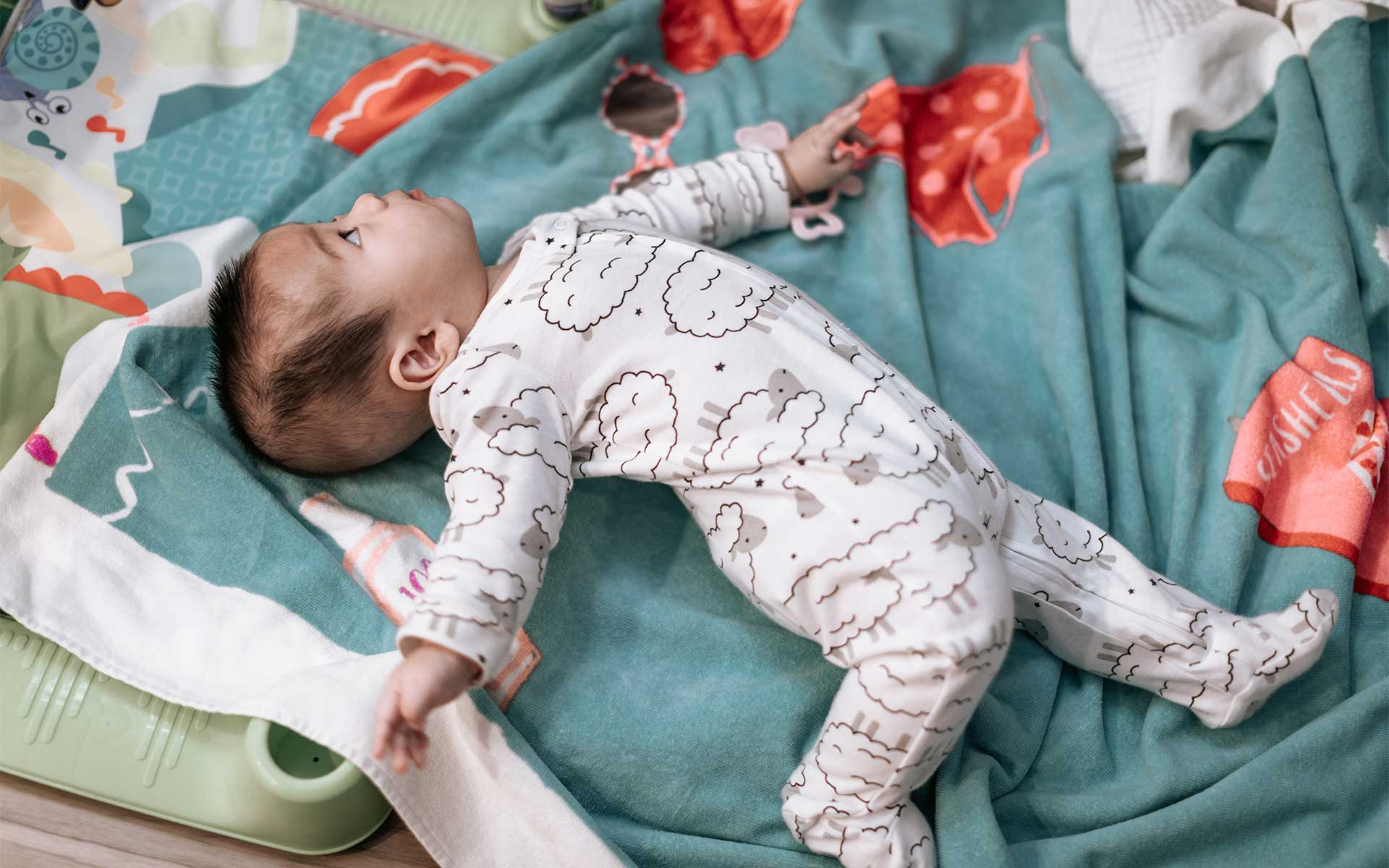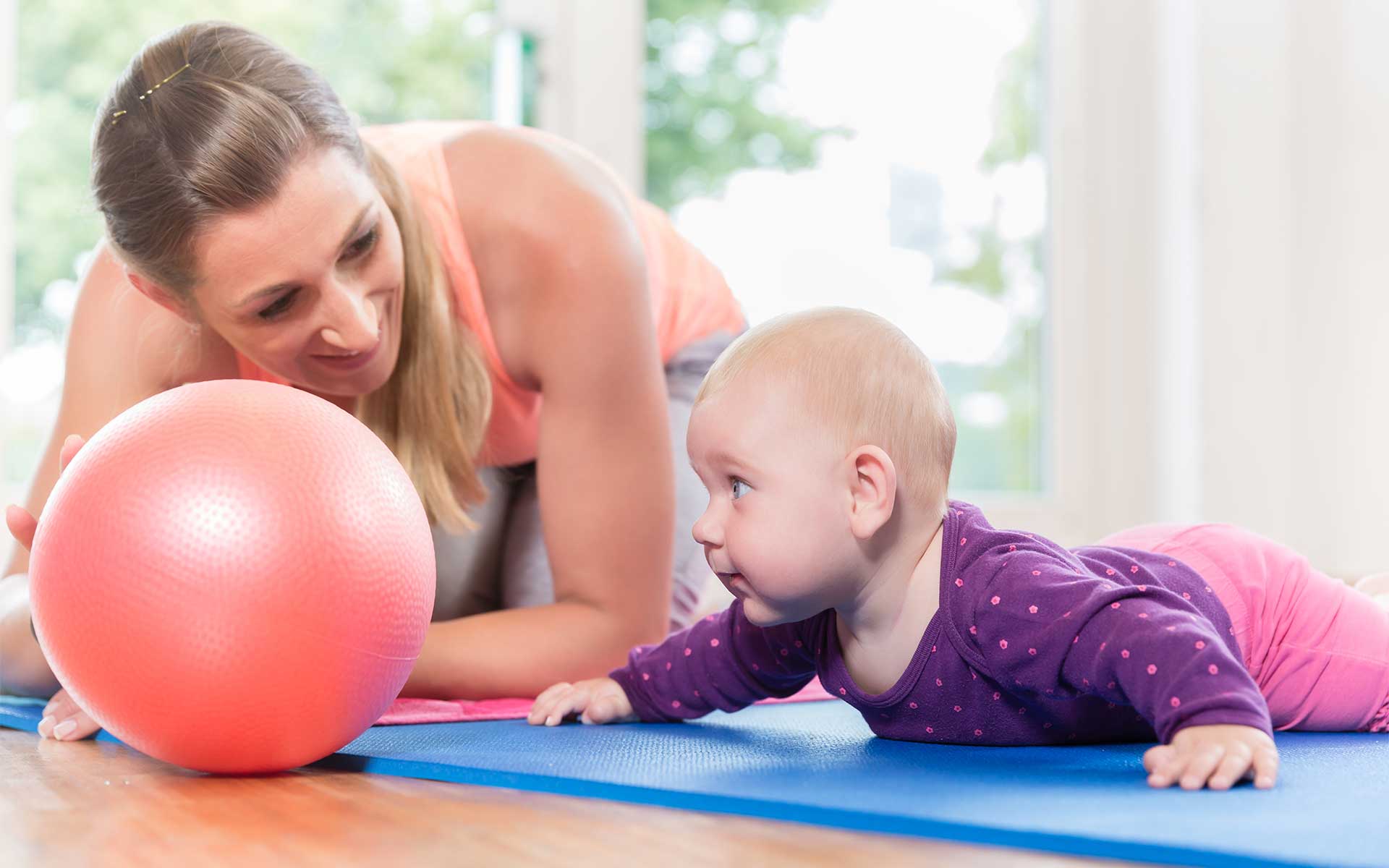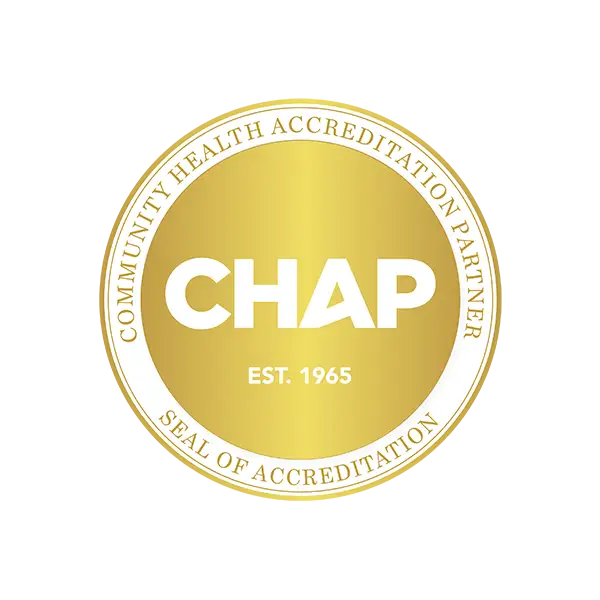
The first year of a baby’s life is filled with exploring and learning – and big developmental milestones! It’s an exciting time for parents and the baby, and practicing purposeful play is part of the magical process of discovery during the first six months of a baby’s journey.
From independently holding up their heads to learning to crawl, babies are learning a lot about their body’s potential during year one of life. One of their first significant physical milestones is rolling over from tummy to back and vice-versa, and it’s also the topic of today’s article.
We’ll answer all your questions about when and how and discuss the importance of “play with a purpose” and how it can help babies achieve this and other milestones. Plus, we’ll share some helpful, purposeful play examples, including how to encourage baby to roll over.
When Do Babies Roll Over?
When babies move from one position to another independently, we call these movements “transitions” – and they are a big part of early development. Babies typically begin to learn and practice transition movements between four and six months, although the timing varies from child to child. Until transitions begin, babies are totally dependent on parents and caregivers for position changes.
Independently rolling over is a big milestone for babies, and it’s the gateway to more milestones like crawling, scooting, and playing. Infants should start rolling over from belly to back anywhere from 3-5 months and back to belly around 4-7 months of age. However, rolling over may happen earlier or later depending on each baby and how much tummy time they are given.
It’s important to remember that every baby is going to develop at its own rate. Don’t be alarmed if your baby isn’t tracking with “other babies”. You know your baby best, and a pediatrician is the greatest source of support for developmental questions. So, do not hesitate to consult with yours about any and all milestone questions.
How To Encourage Baby to Roll Over?
Although babies tend to learn to roll over instinctually as they grow stronger, there are things a parent or caregiver can do to encourage this milestone transition movement. Muscle development is a big part of it, and the following activities can help babies develop new muscles in preparation for big transitions!
Provide Enough Space
First and foremost, your baby needs plenty of unobstructed and safe space to accomplish this milestone. The floor is the safest spot, and a blanket or matt can provide plenty of cushion on otherwise hard floors. Also, since you will likely be on the floor with your baby at these times, providing enough clear space for you, the baby, and any soft toys will ensure plenty of safe space to interact with each other.
Tummy Time
Tummy time is essential to every baby’s development. We covered tummy time in a previous article, and it involves placing your baby’s belly down on a clean floor or mat. Tummy time can begin right away with infants, and it helps them strengthen and develop their neck, shoulder, arm, and upper torso muscles, which they will need to begin transitions, like rolling over. Pediatricians recommend aiming for a few minutes of tummy time two to three times a day, starting as soon as possible after birth.
Exercises to Encourage Baby Rolling Over
There are baby-friendly exercises you can do to help with early muscle development – and entertain them in the process! For example, baby “bicycling” is a great way to get tiny leg muscles warmed up and conditioned. While your baby is lying on his back, mimic bicycle pedaling using your hands to guide their legs through the motion gently.
You can do the same style of movement with their arms to introduce upper torso motion movement. The changing table and tummy time are both perfect for baby exercise since they are already on their back or tummy. Just remember that a baby should never be left unsupervised unless they are in a safe, contained space like a crib or playpen.
Praise your Baby for Rolling Over
Praise is a great form of encouragement for babies. They know your voice, and it is a source of comfort. As they get to know their muscles and how they work through movement, give them lots of eye contact, praise, and encouragement. You can also sing to them during tummy time and while exercising and practicing movements. Whatever you do, the interaction is key to keeping them engaged and motivated to do the “work” their little bodies need to grow.
Play With a Purpose
Purposeful play with babies involves types of interaction or play that help brain development and allow children to gain the skills necessary to grow physically, socially, cognitively, creatively, and emotionally. Purposeful play with babies within the first year can involve using developmentally appropriate toys to help engage your baby into wanting to track objects and grab them – great for developing their budding motor skills!
What Is Purposeful Play?
Purposeful play is focused play between you and your baby that actively seeks to strengthen his or her developmental growth. An important component of purposeful play with your baby is engaging with them and tuning into their reaction to your actions, so you can note what interests or delights them – or what causes them frustration. Remember, they are learning everything for the first time, and you are the guide – make it fun and engaging!
Purposeful Play Examples
The purposeful play takes a little thought, but it does not have to be complicated. Purposeful play will begin early and continue as your baby grows since it is always actively seeking to strengthen a child’s developmental growth. For example, playing with blocks – building, stacking, or knocking them down – are purposeful play examples that help little ones learn cooperation, gross motor skills, and problem-solving – all while building little muscles.
Books are also excellent tools to encourage fun, purposeful play. Kids who listen to a story, pretend to read, look at pictures, and turn pages are learning about language and vocabulary, how to express ideas, interpret pictures, and reading and writing skills. Even when your child is a baby, reading to them has a purpose – babies are never too young for story time with you.
Purposeful Play With Babies
Purposeful play with babies is simple and easy – and usually fun for new parents and caregivers too! For example, when your baby is in tummy time on the floor, you can implement toys to encourage eye tracking by moving a brightly colored toy within your baby’s line of sight. Their eyes will naturally follow the toy, encouraging object tracking and neck movement.
Other examples of purposeful play with babies under six months can include: tummy time on your chest or play mat, shaking a rattle or noise-making toy with them, gently clapping your baby’s hands together, making funny faces, singing and talking, attaching colorful toys to their playmat to encourage grabbing, snuggling with them, or moving colorful toys around them on the mat. Again, purposeful play at this age is all about interacting, encouraging, communicating, and comforting your baby.
Ready to learn how to help your baby roll over? Keep reading to learn about purposeful play activities that can help babies master this monumental milestone.
Purposeful Play for Helping the Baby Roll Over
As tummy time progresses, your baby may surprise you with an accidental roll one day! However, if she isn’t doing it on her own just yet, let’s look at activities geared toward how to teach a baby to roll from tummy to back. Remember, when babies rolling over happens, it can be sudden. So please always practice purposeful play in safe and secure spaces to prevent accidents.
If you are just starting out, say between 3-4 months, purposeful play is the best tool in your arsenal when considering how to help your baby roll over. Here’s an example: pick a soft, even space with plenty of room and lie your baby on its back. Next, gently move one of their legs across the body to the other side.
The goal is to see if the baby will follow with their arm, thereby rolling over from the momentum. It may not happen immediately, which is fine – just keep trying. Give lots of praise when it works!
Additional Strategy on How to Get a Baby to Roll Over
Another strategy is to encourage babies to roll over involves a little help from a blanket. Lie your baby on their back near one side of the blanket. Next, gently lift the other side of the blanket to try and slowly roll them onto their side or tummy. Give lots of praise and smiles if it works. Remember, the first roll for a baby can be sudden and a little scary, so be ready to comfort and praise!
We’ve learned a lot about the power of purposeful play from our many talented pediatric home health therapists, and we believe it’s a beautiful way to nurture and teach through engagement. After all, learning is more successful when interest is high – and fun is happening!
If you or your pediatrician are interested in pediatric home health care in the areas of occupational, physical, or speech/language therapies, or pediatric home health nursing, contact Kids Care Home Health today. We are committed to providing the highest quality pediatric home health care services across the country to children with special needs.

















